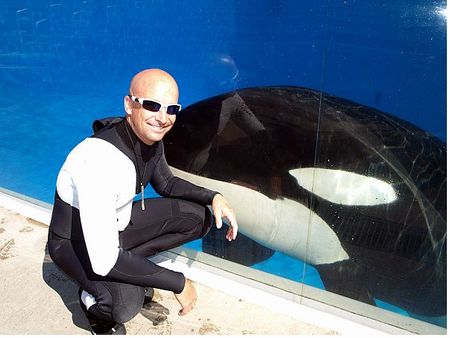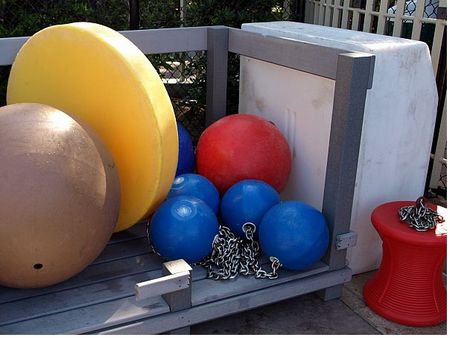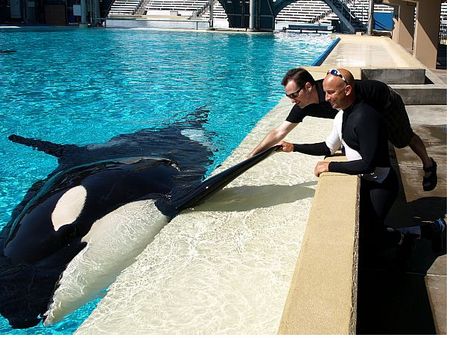
If you ever wondered about the abilities of SeaWorld's trainers to make animals perform... well, just remember that they got me out there, in that suit.
For the next 20 minutes I watched perfectly choreographed chaos -- not from the stadium seats with the rest of the park guests, but from backstage, just behind one of the curtains leading to the performance set of "Clyde and Seamore's Risky Rescue." Sea lions slid past my feet, down a narrow corridor and through the curtain onto the stage. Otters scampered around my legs and up a tiny flight of steps to their position on the top floor of the set. A massive walrus swam from its holding pool behind the set, under the stage and into the stadium's show pool.
Every movement came in response to a cue from a trainer, and every successful move was followed by a reward from that same trainer, whether that movement came on stage, back stage or even on the way to and from the animals' living areas.
SeaWorld's trainers preach the value of positive reinforcement, whether it's to train an 800-pound sea lion to accept eye drops... or to direct a website editor around backstage during a show.
"Like a preschool teacher, you're always there to make it fun and exciting for the animals," said Ken Peters, a 20-year veteran who trains the killer whales at Shamu Stadium.

I met with Peters and SeaWorld's director of animal training, Al Garver, earlier that morning in the holding pools behind Shamu Stadium. As we stood in the "fish room," amid number-coded buckets of herring, smelt, mackerel and salmon (each animal gets its own special mix), Peters explained that food isn't the only reward that SeaWorld's trainers use to reinforce behavior.
"Most of their reinforcement is interacting with us," Peters said. In addition to the primary reinforcement of food, trainers use a variety of "secondary" reinforcements – ice, touch, massages, even toys.

Trainer Dave Roberts, at the Sea Lion and Otter show, said that the use of secondary reinforcements has helped make the shows better over the years.
"Twenty-five years ago, it was 'Do the jump; get the fish,'" he said. "Today, we've come so far, now it's 'Do the jump; get whatever you like.'
"So today, at the end of the day, they are just as eager as they were at the beginning of the day. Twenty-five years ago, it was 'Hey, I'm full. You want a ride across this pool? Call a cab.' The animals were just sated."
But reinforcement isn't just for spectacular jumps.
"Aside from show behaviors, all animals are taught husbandry behaviors," Roberts said. Animals are weighed each day, and trainers and veterinarians regularly collect blood, urine and even sperm samples from the animals. But no one can just walk up to an animal and ask them to stick out a fin. Those procedures need to be taught, and reinforced.
"The aerials are really exciting for the crowds, and the trainers, too, but what a trainer finds most exciting is when a young whale learns those little behaviors for this first time," Peters said. "If you can train the animal to be okay with these things, the trainer knows that they will be okay with all the other things.
"It's like watching a baseball game. Sure, it's nice to watch home runs, but what gets parents most excited? It's seeing their kid get a hit for the first time."

So how do they do it? Peters said that the same basic principles apply to training killer whales as to more common animals, such as dogs.
"I don't think that the water is that important a variable," he said. What does distinguish his training methods is the exclusive use of positive reinforcement.
"There's no yanking on a chain, like some do with a dog," he said. "If you use punishment on a whale, it will punish you back."
"When you get in the water with an animal," Garver said, "you want it to be all positive."
Garver also said that working with killer whales actually can be easier than working with some of the smaller animals in the park.
"Killer whales are at the top of the food chain," he said. "They are not afraid of people the way that other animals are. So they can get into training much quicker. Other animals, farther down the food chain... they have an innate flight response that you can spend an inordinate amount of time getting over."
Garver and Peters pointed to the park's Commerson's Dolphins as an example of an animal whose status at the bottom of the food chain made them "skittish" and more difficult to train. Still, the killer whales' status at the top of the ocean food chain does present challenges.
"With whales, you have to meet them halfway," Peters said. "A lot of times with dogs you can say 'Hey, I'm in charge.' If you try that with these guys [he pointed to the killer whales in the show pool behind him], that's, uh, not going to work real well."
After talking with Peters and Garver, I walked over to the Sea Lion and Otter Stadium, where I met Roberts and saw him and his crew bring out the sea lions for their morning weighing, treatment and feeding.

I followed Roberts back to the sea lions' pool, where we gave the command for the three sea lions (or "dogs," as the trainers call them) to move on to the rocks at the back of the pool. Then he called one of the sea lions by name, who then swam to the gate at the front of the pool. Roberts opened the gate for Duke, whom Roberts then gave a command to move to a "safe" position on Roberts' opposite side from me.
Roberts rewarded all three sea lions for their cooperation, then gave the command for Duke to follow us to the scales, a large metal plate on the outside floor behind the stadium.
That's where I watched the sea lions and walruses be weighed. One by one, each waddled up to the scales and waited patiently, in position, for the trainer to record its weight and reward it with a helping of fish.
Most impressive to me was McLean, a sea lion who had had cataracts, tilting his head to each side, on command, to accept drops in each eye.

Man, I gotta get these guys to come to my house to train my kids to take medicine, I thought. But then I figured Natalie and Brian wouldn't be real enthusiastic about raw mackerel as a "thank you."
So, because some Theme Park Insider readers wanted to know, how does someone get a gig as a SeaWorld trainer?
SeaWorld's director of education, Joy Wolf (yes, that's really her name), gave me a hand-out with the requirements:
Garver said that the swim test eliminates people who are not comfortable in the water, the microphone test and audition eliminates candidates who are not comfortable speaking in public and the interview helps SeaWorld's current trainers get a sense whether a candidate has the right attitude to handle the challenges of animal training.
"Trainers are our own worst critics," Garver said. "After a session, we'll pick apart everything that worked or didn't."
"If you can't take constructive criticism," Peters said, "this probably is not the right position for you."
Monday, Theme Park Insider editor Robert Niles writes about slipping on a wet suit and getting in the tank with SeaWorld's beluga whales.
Tweet
The Beluga whale interaction I'll write about on Monday was the same Wild Arctic interaction that SeaWorld sells -- I did it with seven others -- but, again, that was arranged for me through the SeaWorld PR department, so that I could get up-close photography for use on TPI. Since it was an arranged visit, I won't be evaluating or reviewing the interaction, just describing it in first-person detail and showing you the photos.
Let’s keep hoping the Busch Family keeps these beautiful parks.
So, yeah, they pee in the tank. But let's put it this way: the toilet is always flushing.
FWIW, SeaWorld San Diego pulls its tank water from nearby Mission Bay. So it is the only SeaWorld park that's using natural salt water. SeaWorld filters the sea water before putting in the tanks, then again before it is recycled into the bay. Several trainers made a point of saying that the water is cleaner when SeaWorld puts it back in the bay than when SeaWorld takes it out.
This article has been archived and is no longer accepting comments.